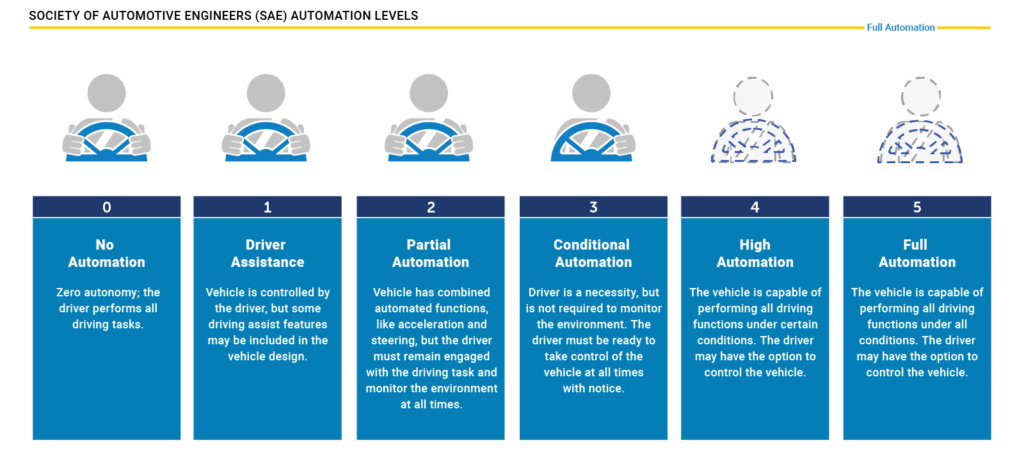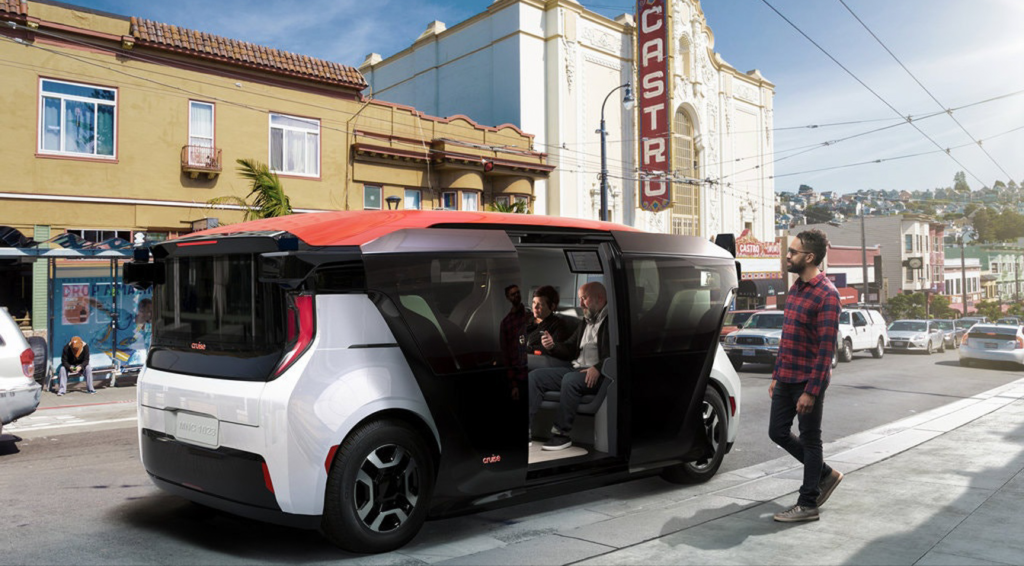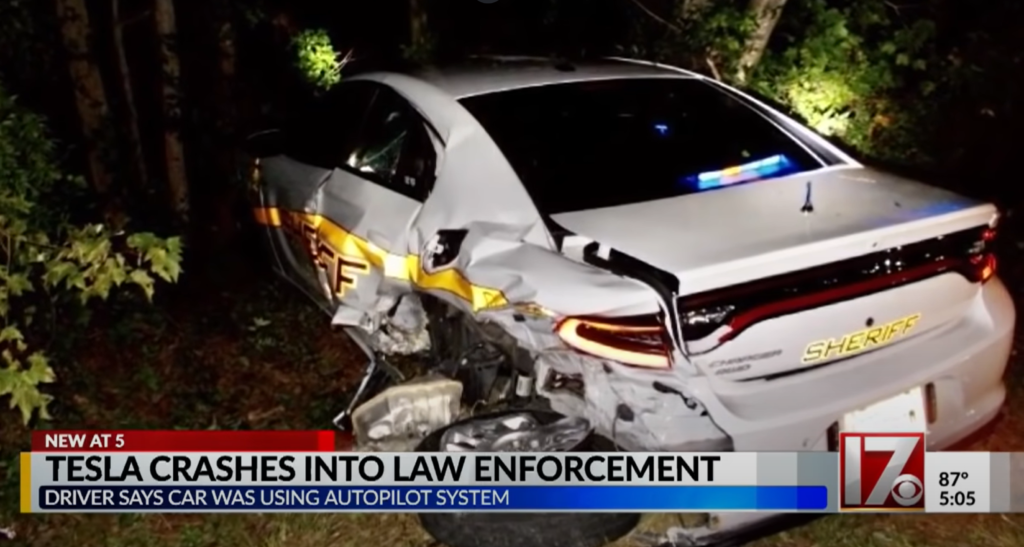Are autonomous vehicles ethical?
In recent years the automotive industry has begun undergoing a transformation that could potentially change how people perceive automotive, in addition to completely transforming our current infrastructure. Various car manufacturers and tech companies such as Tesla, GM/Cruise, VW Group, Google’s Waymo, and Apple are investing heavily in full self-driving /autonomous vehicles.
The future of the automobile industry is uncertain, as deadly accidents and advances in vehicle safety technology have sparked controversy about autonomous vehicles and whether it is ethically and legally right to pursue this technology. Should we put our lives and the lives of our children in the hands of a machine? Or, should a human be behind the wheel of an automobile at all times?

The American Society of Mechanical Engineers (ASME) is a non-profit organization that encourages collaboration, across all engineering disciplines; to help the engineering community develop solutions to benefit the lives of the public (Workers, 2016). ASME sets safety standards and guidelines across the engineering field to help protect the consumer. As an engineer, your priority should be the safety of the public, as stated in the ASME code of ethics.
What is an autonomous (self-driving) vehicle?
A self-driving or autonomous vehicle (AV) is a vehicle that can drive itself from a starting point to a predetermined destination without intervention from the driver. The Society of Automotive Engineers (SAE) has developed 5 levels of autonomy to classify all vehicles. The vast majority of vehicles on the road today are level 2 or lower such as Tesla’s Autopilot and General Motors’s Supercruise system

General Motors is working on a new Ultracuise system which it claims will have level 3 autonomy. This system will be available in its new Cadillac Celestiq which will go into production in December 2023. Currently, the companies that are closest to achieving full level 5 autonomous vehicles are GM’s Cruise and Google’s Waymo.
However, neither one of these two companies plans to sell its vehicles to the public, as these vehicles are intended more for ridesharing purposes. The majority of the fleet of vehicles that these two companies will operate will be more like shuttles, most of which will not even have a steering wheel.

Currently, Cruise is providing rides to people in San Francisco but will be expanding to Phoenix and Austin soon. Waymo has also been testing its vehicles in the Phoenix Metro Area since 2016 and is waiting on approval to expand to San Francisco.
Are autonomous cars a good idea?
In any double-sided issue like this one, emotions can quickly come into play and keep one from acknowledging facts. Whenever a person is presented with a new idea or technology such as driverless vehicles it is easy to want to resist change or be afraid or cautious of this new technology.
However, you should always be aware of your emotions. Awareness of emotions in self is as defined as, “understanding how one’s emotions affect one’s thinking and behavior and understanding the influence of beliefs on behaviors” (Wang, et al, 2012). Overall the public sentiment toward autonomous vehicles does seem to be improving as can be seen in the graph below where participants were asked about their views on AVs.

This study conducted by the University of Macau in China found that the top four reasons why people oppose AV are (1) safety concerns, (2) unemployment, (3) legalization, and (4) uncertainties. The three most common reasons why people support AVs are (1) appreciation of technology, (2) safety benefits, and (3) convenience [H.N. Io et al.].

Advocates of the advancement of autonomous vehicles claim that we should continue to pursue this technology and they state the following warrant, under the Fundamental Principles of the ASME Code of ethics Principle 1 engineers should “use their knowledge and skill for the enhancement of human welfare” (Workers, 2016). They also justify their argument based on the fundamental canon 1 “Engineers shall hold paramount the safety, health, and welfare of the public in the performance of their professional duties” (Workers, 2016).
Opponents of the advancement of autonomous vehicles justify their claim that the cost of this technology is not worth the benefit, it is too risky to continue. Opponents of the advancement of autonomous vehicles state the following warrant, based on the ASME fundamental principle 2. Fundamental Principle 2 under the ASME code of ethics is engineers should always “be honest and impartial, and serving with fidelity their clients (including their employers) and the public” (Workers, 2016).
Opponents also base their argument on fundamental canons 1 and 8. Cannon 8 is “Engineers shall consider environmental impact and sustainable development in the performance of their professional duties” (Workers, 2016).

Why should we have autonomous vehicles?
Principle 1 of the ASME code of ethics states that engineers should always use their skills and knowledge for the betterment of all people (Workers, 2016). Advocates of the advancement of autonomous vehicles claim that this technology will make life easier for everybody, and some of the backings they use to support their argument are as follows. Even though huge advancements in this technology are recent the idea of driving features that enable full self-driving cars is nothing new.
In 1939 General Motors’ “Futurama” exhibit displayed a concept car that transported people automatically on trips on both urban streets and intercity highways (Ozguner, et al, 2011). Since then small advancements in this driving technology have been made over the years.
During the 1940s the first advancement made was the automatic transmission which no longer required the driver to manually shift gears while driving. In more recent years the Japanese introduced adaptive cruise control (ACC) systems in the Mitsubishi Diamante in 1995 followed by Toyota in 1996. Both these automakers incorporated automotive radar sensors to measure the distance, velocity, and heading angle of surrounding vehicles.
This technology was then adopted by the European and American markets (Ozguner, et al, 2011). These advancements in the automotive industries are now widely accepted and used by most cars on the road. Most consumers would find it weird when purchasing a new vehicle if these features were not included, but it was these and several other advancements throughout the years that are making autonomous vehicles possible.
This technology seems futuristic, but many people predict in the future it will be a standard feature, and “…it’s only a matter of time before autonomous autos rule the road” (Gorzelany, 2016). As people get more comfortable with AV technology, handing over control of their vehicle to a computer might not seem so strange and foreign.

Advocates of the advancement of autonomous vehicles also supply the following backing for their claim, on Thursday, September 16th, 2016 at 2:00 am on I-95 northbound in Newcastle Delaware a tractor-trailer driver fell asleep behind of wheel causing a major accident, spilling pennies all over the interstate.
The accident caused the highway to be shut down until 3:15 pm to allow for clean-up. For 13 hours I-95 northbound was closed. This accident caused traffic jams across the state as traffic was redirected through various smaller roads (McCormick 2016).
The first fundamental canon of the ASME code of ethics states that engineers must foremost hold the safety, health, and welfare of the public as a priority (Workers, 2016). Advocates of autonomous vehicles claim that human error is the number one cause of automotive accidents, therefore, autonomous vehicles will make the roads safer for everyone.
Their backing to support this claim is that from 2005 to 2007 the U.S. Department of Transportation estimated there were 2,189,000 crashes nationwide that involved 4,031,000 vehicles, 3,945,000 drivers, and 1,982,000 passengers (Singh, 2015). Of all the crashes nationwide it was estimated that 94 percent (±2.2%) of them were due to driver error.

Only 2 percent (±0.7%) of the crashes, were due to mechanical errors such as a component’s failure, and only 2 percent (±1.3%) of crashes, were a result of environmental causes such as a slick road or fog. The final 2 percent of the accidents were a result of unknown critical reasons (Singh, 2015).
Of the 94 percent of accidents due to driver error, 41 percent (±2.2%) was due to recognition error and 33 percent (±3.7%) of the crashes were due to decision error. Recognition error means, internal and external distractions, and poor inspection of surroundings. This figure was also taken before texting and driving became a big issue across the United States. As a result accidents due to recognition errors have most likely increased. Decision error meant driving too fast for conditions, incorrect assumption of others’ actions, and illegal maneuvers (Singh, 2015).
How autonomous vehicles will change the world?
AVs promise a future with safer public roads and reduced traffic congestion. The vast majority of traffic accidents are a result of human error. Of the 94 percent of the accidents, which were caused by driver error 74 percent, were a result of distracted driving and speeding. These accidents can in most cases be avoided if driver-assist features were used.

“Accidents on highways are one of the major sources of loss of life in modern society. Significantly more lives have been lost in highway accidents than in terrorism or wars” (Bulumulle & Bölöni, 2016). Most of these accidents are due to human error or lack of awareness of the surroundings. “Side-sweep accidents account for 4%–10% of all crashes” (Bulumulle & Bölöni, 2016).
It is common for drivers to not properly check their blind spots to notice blocking vehicles before changing lanes. These accidents are 99% avoidable if drivers just take the time to properly check their blind spots.
The majority of these traffic accidents which are caused by human error can be explained by a lack of self-management. While driving there is many different distractions on the road and it can be difficult to stay focused, which can lead to a dangerous situation. This is one of the biggest advantages of self-driving vehicles, they do not get distracted, and they do not lose focus, thus eliminating all these accidents from occurring.

All these accident also leads to increased traffic jams. Being stuck in traffic can also easily lead to drivers getting annoyed or irritated leading you to lose focus and make bad choices (road rage), which as a result, can affect the vehicles around you. Another huge benefit of autonomous vehicles is the reduction or elimination completely of phantom traffic.
Phantom traffic is usually caused by human error or reckless driving, such as following the vehicle in front of them too closely, jumping lanes, or just being unaware of their surroundings. This type of reckless driving leads to waves of brake lights on an interstate for no apparent reason. Since AVs always keep the same distance from the vehicle in front of them, this type of reckless/aggressive driving would become a thing of the past.

Why should driverless cars not be allowed?
Opponents of the advancement of AVs state the following grounds, in September 2015, the Environmental Protection Agency (EPA) discovered that the German car giant, Volkswagen, sold vehicles in the United States that were equipped with software that could detect the car being tested; and as a result, changing their performance accordingly to improve its emissions results (Hotten, 2015).
However, Volkswagen is not the only car giant which been in trouble in recent years. Honda, Nissan, and Ford have had huge airbag recalls (Takata Air Bag Recalls), which have affected millions of vehicles where the driver was at greater risk from the airbag deployment than from the actual accident.
Toyota also had the floor mat recall where the gas pedal would get stuck and the driver would no longer be able to slow down the vehicle. General Motors had an ignition switch recall where passenger vehicles would shut off while driving. Automotive companies outsource different parts of the vehicle to save money, but this decision comes at a great cost to the general public.

The fundamental principle 2 of the ASME code of ethics states that engineers should also be honest and impartial in their work, and to the public. Many opponents of autonomous vehicles state that the automotive industry does not have the best record when it comes to being honest and impartial with the public. Large scandals, involving the automotive industry have become common in today’s age.
NHTSA is currently investigating the Cruise RoboTaxis for sudden braking and blocking traffic. There are also videos of the Cruise RoboTaxis getting pulled over by the police in San Francisco. As the cop gets out of the car the vehicle just drives away.
However Cruise is not the only company getting hit with NHTSA investigations, in the Fall of 2021, NHTSA also opened an investigation into Tesla’s Auto Pilot System. This investigation was a result of 11 crashes that occurred while Tesla owners had autopilot engaged.

Opponents of autonomous vehicles also state the following warrants that under the Fundamental Principles of the ASME code of ethics Principle 1 engineer should “use their knowledge and skill for the enhancement of human welfare” (Workers, 2016), and this new technology can be dangerous. Driving is a physically and mentally demanding task, and there are times when a split-second decision could mean life or death.
A scenario that is usually brought up during autonomous vehicle debate is how a car makes a decision when it comes to a “lose-lose” situation. The common “crash avoidance problem”, is when the vehicle has to decide on which person to kill, where a crash is inevitable (Coeckelbergh, 2016). How can an engineer consciously program a machine to make those decisions, to value one life over another?
What is the problem with autonomous vehicles?
Driving is a complex activity, which many people fail to recognize. A good driver relies on a broad range of skills and actions; some of these skills and actions are easier to automate others are not. For example, driving at a steady speed on an open road is very easy, as a result; driver assist systems such as cruise-control systems have been used in automobiles for many years (Shladover, 2016).
Even though some individuals are trying to phase out human drivers, human drivers are more than able to avoid major automobile accidents (Shladover, 2016). Vehicles are more intelligent and come with many features to help simplify driving, yet it is an enormous leap from current systems to fully automated driving (Shladover, 2016).
Another claim that opponents of autonomous vehicles usually bring up during the debate of autonomous vehicles is also the laptop freezes-up argument. What happens if you are driving and the software responsible for driving a car freezes up or has a glitch? Any delay in software responsiveness could be detrimental not just to the passengers in the vehicle but to all the surrounding traffic.

Software for automated driving must, therefore, be designed and developed to dramatically different standards from anything currently found in consumer devices (Shladover, 2016). Another obstacle that must be overcome with autonomous vehicles is the issue of hacking.
“With autonomous vehicles, criminals or terrorists might be able to hack into and use their cars for illegal purposes such as drug trafficking or, even worse, terroristic attacks” (König, 2017). Cyber-attacks have become more common in recent years and this new technology might give criminals and terrorists a new method of committing illegal activity.
A major warrant that opponents of autonomous vehicles present is, regardless if you are for or against autonomous vehicles there is still one major issue that must be addressed, fully autonomous vehicles are not legal, and all vehicles on the highway require human supervision (Bulumulle & Bölöni, 2016). One of the main reasons for this is because of the huge legal liability and ethical issues autonomous vehicles present. One of the main ethical issues with autonomous vehicles is who is responsible when there is a system failure and someone gets hurt.
During a car accident, it is easy to determine who is responsible when something goes wrong. The same cannot be said if there is a car accident involving autonomous vehicles, who is responsible then? The owner of the car? The car manufacturer? The car? (Coeckelbergh, 2016). The grounds to support the warrant are that various people have stated that individuals will only claim responsibility for what they can control and they avoid or reject responsibility for what they cannot control.

If an individual lacks control, then he or she is not responsible. This mentally will spark up much controversy about who is responsible for the autonomous vehicle, if the owner is not controlling then he will argue he should not be responsible (Coeckelbergh, 2016). The change to fully autonomous vehicles will be very slow and is not something that will happen overnight. Even if autonomous vehicles become commercially available by the end of 2020s the majority of vehicles on the highway will remain human-driven (Bulumulle & Bölöni, 2016).
Privacy is another issue, which must be addressed when talking about autonomous vehicles. Another claim made about the advancement of autonomous vehicles is that many people are also concerned that machine learning in fully automated vehicles is the next step towards higher surveillance because these vehicles can be tracked, to find out where you are and where you have been or where you are going (König, 2017).
In March 2021 the Chinese government banned Tesla cars from entering Chinese military complexes and housing compounds, over sensitive data being collected by cameras built into the vehicles. In the summer of 2022, Tesla cars were also prohibited from entering the Chinese coastal district of Beidaihe for two months over concerns about spying amid a meeting of the country’s leadership. This type of suspicion by the Chinese government only furthers the worry that some individuals might have over self-driving vehicles being used for surveillance purposes.
Conclusion:
Both arguments for and against the advancement of autonomous vehicles are strong. It would seem after a careful review of both arguments, the opponents of autonomous vehicles incorporate fallacies into the arguments.
The fallacy used was “Emotional Appeal”. The places where this fallacy is used are in the following two arguments: what if a car must choose between two human lives and automated vehicles are the next step towards higher surveillance? These two arguments are fallacies because it is intended to introduce fear into the reader as a way to persuade them against continuing this technology
As an engineer, I am for the advancement of driver-assist and fully autonomous vehicles. As an engineer, you always do your best to make every design of the highest quality possible, but there is only so much you can do. No solution is ever perfect because life is not perfect so the idea of achieving absolute perfection is unrealistic.
Autonomous vehicles are not promising to solve car accidents; but they will minimize one of the main causes of car accidents, which is human error. Human errors such as impaired driving and distracted driving are the source of many more accidents than accidents caused by mechanical error. I truly believe this technology will make public roads a safer place.
References:
- Bulumulle, G., & Bölöni, L. (2016). Reducing Side-Sweep Accidents with Vehicle-to-Vehicle Communication. Journal Of Sensor & Actuator Networks, 5(4), 1-16. doi:10.3390/jsan5040019
- Coeckelbergh, M. (2016). Responsibility and the Moral Phenomenology of Using Self-Driving Cars. Applied Artificial Intelligence, 30(8), 748-757. doi:10.1080/08839514.2016.1229759
- Gorzelany, J. (2016). Tech To The Future. Forbes, 198(6), 74-80.
- Hotten, R. (2015). Volkswagen: The scandal explained BBC News.
- Hio Nam Io, Chang Boon Lee, Zhaotong Lian, Sentiments about autonomous vehicles, Journal of Engineering and Technology Management, Volume 66, 2022, 101717, ISSN 0923-4748, https://doi.org/10.1016/j.jengtecman.2022.101717. (https://www.sciencedirect.com/science/article/pii/S0923474822000479)
- König, M., & Neumayr, L. (2017). Users’ resistance towards radical innovations: The case of the self-driving car. Transportation Research Part F: Psychology And Behaviour, 4442-52. doi:10.1016/j.trf.2016.10.013
- McCormick A. (2016) Truck Crashes, Spills Pennies On I-95 In Delaware. ABC News.
- Ozguner, U., Redmill, K., & Acarman, T. (2011). Autonomous Ground Vehicles. Norwood: Artech House
- Shladover, S. E. (2016). The Truth About “Self-Driving” Cars. Scientific American, 314(6), 52-57.
- Singh, S. (2015, February). Critical reasons for crashes investigated in the National Motor Vehicle Crash Causation Survey. (Report No. DOT HS 812 115). Washington, DC: NHTSA
- Wang, N., Wilhite, S., Wyatt, J., Young, T., Bloemker, G., Wilhite, E. (2012). Impact of a college freshman social and emotional learning curriculum on student learning outcomes: An exploratory study. Journal of University Teaching & Learning Practice, 9(2), 1-20.
- Workers, N. A. (Last revised 2006, November). ASME Code of Ethics (Society Policy of the Professional Conduct of Mechanical Engineers). New York, NY: ASME.

